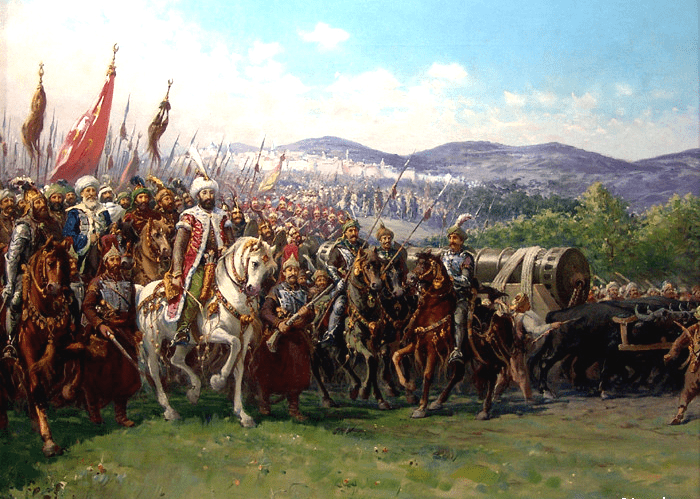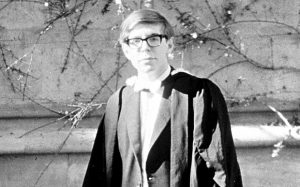How do you beat a good defense? By having a better offense. In the year 1453, one of the greatest showcases of artillery advancement in history took place. There were two groups in conflict, each known for a strength opposite the other: one was known for its indestructible defensive walls, and the other known for its weapons of assault. These two sides were the Byzantines and the Ottomans. The event bringing them together was siege of the Byzantine capital Constantinople. The aftermath of this siege was the recognition of the Ottomans as a new major power in the world. Their victory over the Byzantine Empire, heir to the ancient Roman Empire, marked the waning of the Middle Ages and the early dawning of a new age to come, the Early Modern era.

Mehmed II was the ruler of the Ottoman people when he seized control of the Byzantine Empire. At age eighteen, when he first got power, there was a backlash within the ranks of his commanders. Mehmed II was forced out of power. His father, Mehmed I, had to help his son regain his power. This event fueled Mehmed II’s sense of conquering, having been betrayed by his own people for power.1 The Ottoman army was known as one of the first groups to use gunpowder. In their military attacks, it was a clash of great defense versus a great offense. At the age of twenty-one, Mehmed II lead a military attack against the Byzantine Empire with a weapon known as the Orban cannon, the biggest cannon ever seen in the medieval world. The measurements of this unique cannon were about 27 feet long. It was walled with 8 inches of solid bronze and had a diameter of 30 inches. The target was the unbreakable walls of Constantinople, which the maker of the cannon had had a great deal of time studying. Constantinople was the yet-unconquered capital, and for over a thousand years it had only been captured once, in 1204. The Ottomans saw it as a perfect capital for the empire they hoped to rule. The walls, however, posed a great problem for any foreign invader, because of their height and depth. Therefore, Mehmed II had this special cannon built. The rest of the Byzantine Empire had already been conquered by the Ottomans, and Constantinople was the last remaining piece to be taken.2
The architect behind the destructive cannon was a man named Orban. There is not much information on his earlier life. We have very little information about him regarding the creation of his cannons. Orban was a Hungarian cannon maker. He was opportunistic. No matter who employed him, he just wanted to create the next big cannon. He first began his campaign at the unconquered city of Constantinople, stopping there to sell his services and ideas to Emperor Constantine XI. He liked Orban’s idea for a super-weapon cannon, but he was not willing to offer him much funding for the project. Growing frustrated with Constantine’s financial support, Orban decided to go to the opposing force in the war. He went to see Mehmed II and offer him his services. When the two met, “Mehmed asked Orban if he could cast a cannon large enough to smash the walls of Constantinople.” Orban replied with “I can cast a cannon of bronze with the capacity of the stone you want. I have examined the walls of the city in great detail. I can shatter to dust not only these walls with the stones from my gun, but the very walls of Babylon.”3 Orban proceeded to work on the cannons, and once he was finished, Mehmed ordered a test shot in front of his palace. The test was amazing. The cannon shot its projectile over a mile. The fear it then would strike into the opponent’s hearts was incomparable to anything known. The sheer power of the weapon was terrifying.

With the final product finished, the hard part began: the transportation of the cannon for a trip of 140 miles to the destination. The moving team was quite impressive. With 200 men and 60 oxen, it took six weeks for the guns to arrive, along with 80,000 soldiers all under the command of Mehmed II.4 His men cleared the tree lines and anything else in its path for a clear shot at the wall. An eyewitness of the battle described the destruction of the cannon: “sometimes it would destroy a complete portion of the wall.”3 This was the beginning of the end for the most indestructible object in the world. Mehmed II was ruthless in his tactics, cutting off all escape routes and all incoming supplies. The result was a 53-day siege, leaving the walls in ruins.

This, the dawn of the gunpowder era, spelled the end of the Middle Ages and the beginning of a new age of warfare. The effects of this battle saw a major change in the modern army’s artillery and the use of gunpowder for armys around the world. The recognition of the Ottoman Empire as a world power increased after this war, along with Mehmed II’s reputation in the empire.
- Charles Foster, “The fall of Constantinople and the end of an empire,” Contemporary Review Vol. 288 Issue 1682 (Autumn 2006): 379. ↵
- Franz Babinger, Mehmed the Conqueror and His Time (New Jersey: Princeton University Press, 1978), 85. ↵
- Roger Crowley, “The guns of Constantinople: history’s first great artillery barrage, in 1453, shattered the Byzantine capital and changed warfare forever,” Military History Vol. 24 Issue 6 (Sept 2007): 44. ↵
- World History Encyclopedia, 2011, s.v. “The Ottomans as a Gunpowder Empire,” by Alfred J. Andrea and Carolyn Neel. ↵
- Roger Crowley, “The guns of Constantinople: history’s first great artillery barrage, in 1453, shattered the Byzantine capital and changed warfare forever,” Military History Vol. 24 Issue 6 (Sept 2007): 44. ↵



43 comments
Daniel Matheu Baldor
It was a really interesting article, where you can see how weapons have improved over the years and the impact they can have in a battle. People always talk about great empires and they never mention Ottomans, who were able to build this huge cannon that help them to destroy the Wall from Constantinople, which led to its fall, beginning a new era.
Alondra Lozano
I had previously learned about the Ottoman empire, but never came across this. It was a really interesting article that made me really think about how great the Ottoman empire really was. What really caught my attention was how the Ottomans came across the architect that knew exactly how to destroy the wall and had traded sides and helped destroy the wall of the opponent he was gonna work for.
Anthony Coronado
An opportunity person has always been deemed a natural double-crosser in history, with money and respect always being the reason for people to fuel them to represent other countries, often against the predecessor country. The article construction and transportation is shocking as with the figures of the cannon power and weight, as well as the image gathered of the actual cannon, does that article a great representation.
Giselle Garcia
I didn’t know exactly how Constantinople fell prior to reading this article, but I now discovered that an innovative cannon during that time period was crafted to destroy the city walls. Mehmed II and the Ottomans had an extensive military advantage with their developing weapons and this resulted in their success in capturing Constantinople. The Ottomans were finally recognized as a strong world power and were responsible for the introduction of gunpowder in armies across the world.
Melissa Garza
I find it amazing that the Ottoman Empire was one of the first empires to use gunpowder, and they thought the walls of Constantinople were indestructible at the time. It’s very interesting how Orban, the creator of the super-cannon, was so passionate about his studies and so driven. I can only imagine how people would have reacted to seeing this type of weaponry that was never seen before. Overall, what a great, informative article!
Sofia Almanzan
I had heard of constantinople before but I had never knew how the city fell. I found the use of gunpowder interesting because it shows the ways that humans evolve to destroy one another. It is extremely sad that humans keep coming up with new ways to destroy ourselves with.
Nathaniel Bielawski
The siege of Constantinople shows that the latest technologies can turn the tide of any battle. I think that Orban was the first to understand the importance of artillery in battle. Perhaps Orban changed the course of history toward gunpowder based weaponry. Modern armies still use artillery and similar weaponry to siege cities and countries to this day.
Mia Hernandez
Over the years I’ve heard about Constantinople but not necessarily about what had happened there. I find it astonishing that the Ottomans were able to develop such a “modern” type weapon to take down Constantinople. Not only did it show that the Ottomans had a strategic advantage but it showed that they were becoming more technologically/ militarily advanced.
Sara Guerrero
Creating such a massive cannon really did well for the Ottomans they were able to take over Constantinople. It shows how well studied the city was and what ideas and military machinery was able to help the ottomans win a city that was impossible to get through. It took warfare to a whole new level and definitely influenced others to create a great artillery like the Ottomans. I didn’t know about this before I read this publication, but it does a great job describing what really helped the Ottomans win over Constantinople and gave me a clear image in my head.
Zachary Kobs
Prior to reading this article, I had zero knowledge of Mehmed II let alone his revolutionizing of military artillery. With the skills of a creative cannon builder and the drive of a prophet to be in power of the best assault weapons, a new cannon was built dubbed the Orban cannon. Through the cannon, the Byzantine empire was finished off and the Ottoman Empire was finally recognized as a world power.